Biology Questions and Answers Form 3 – High School Biology Tests/Exams
Biology Questions and Answers Form 3
KCSE Revision Questions and Answers
K.C.S.E Online Revision
1. a) i) What is meant by the term binomial nomenclature?
scientific system of naming organisms using the generic(genus) and specific (species)
ii) State briefly the general principles of classification of living organisms
scientific names must be in Latin or should be latinised
family names are formed by adding the suffix “idea” to the stem of the genus e.g the genus Rana become Ranaidea
generic names should be a single unique name
b) State the main characteristics of the five kingdoms of organisms
i. Monera
e.g. bacteria
unicellular (single celled)
prokaryotic (genetic material not surrounded by membrane)
cell Wall without cellulose
lack most organelles
small in size (microscopic)
ii. Protista(protoctista)
single celled(unicellular)
eukaryotic (most cell organelles present)
when cell Walls are present have no cellulose
e.g. protozoa and algae
usually microscopic
iii. Fungi
have hyphae (which form mycelia)
absence of chlorophyll
have rhizoids (lackroots, leaves, stem)
have spore forming structures (sporangia)
e.g. mucor, rhizopus
iv. Plantae
most are green/contain chlorophyll
autotrophic/feed by photosynthesis
cells have cellulose cell walls
respond slowly to stimuli (tropism)
lack locomotion (are stationary)
indefinite growth (at meristems)
lack specialized excretory structures
v. Animalia
cells do not have cell walls
most carry out locomotion
heterotrophic
fast response to stimuli (tactic)
have specialized excretory structures
c) Describe the economic importance of:
i. Fungi
some cause decay to our food
some cause diseases to humans and animals e. g. ringworms
may be used as food e. g. mushrooms, yeast
some are used in production of antibiotics e. g. penicillin, chloromycin, streptomycin
yeast is used in brewing industry, baking and source of vitamin B
many cause diseases to our crops e. g. late blight
important in recycling nutrients in soil since they cause decay of organic matter
mycorrhizal association in forest development may help in Water intake/absorption
help in nitrogen fixation
ii. Bacteria
are useful in the manufacture of antibiotics
silage formation,
fermentation of cheese, butter, milk yoghurt
curing of tea, tobacco and retting flax
formation of vitamin B12 and K
enzymes such as amylase and invertase
hormones such as insulin ‘
vinegar, acetic acid, lactic acid, citric acid
in septic tanks and modern sewage Works make use of bacteria
biogas production
saprophytic bacteria are used in compost decomposition or cause decay
symbiotic bacteria are used in compost decomposition or cause decay
symbiotic bacteria in herbivores/ruminants help in digestion
some diseases in animals/humans and plants are caused by bacteria
many bacteria cause‘ food spoilage/decay
nitrifying and nitrogen fixing bacteria increase soil fertility/make nitrates available
denitrifying bacteria reduce soil fertility/convert nitrates into nitrogen/reduce nitrates
d) State the main characteristics of the following division of kingdom plantae
i. Bryophyte
e.g. mosses and liverworts
presence of rhizoids
lack of vascular tissues (lack phloem and xylem)
body pans not differentiated into root, stem, leaves
capsule or seta
gametophyte generation dominant.
ii. Pteridophyta
e.g. ferns
has true roots, stems and leaves
fond with sori on under-surface
vascular tissues present
sporophyte generation is dominant
iii. Spermatophyte
photosynthetic
well differentiated into roots, stems and leaves
well developed vascular system
seed bearing plants
e) Name sub-divisions of spermatophyte and state the characteristics of each class
i. Gymnospermae (cornifers)
naked seeds (exposed
are all woody trees
reproduce by means of cones
show xerophytic characteristics
xylem have tracheids but lack vessels
phloem lacks companion cells ~
single fertilization
pollen lands directly on ovules
ii. Angiospermae (flowering plants)
reproduce by flowers
seeds enclosed (in fruits)
flowers bisexual hence double fertilization
herbaceous
pollen grains land on stigma of pistil
xylem contains vessels
phloem contains companion cells
ovules contained in ovary
iii. Name the classes and state characteristics of angiospermae
Dicotyledonae
two seed leaves
network venation of leaves
regularly arranged vascular bundles
tap root system
broad leaves
secondary growth occurs
Monocotyledonae
one seed leaf
parallel venation of leaves
irregularly arranged vascular bundles
fibrous root system
narrow leaves
sheath like leaf stalk (petiole)
no secondary growth
iv)State the importance of plants
balancing carbon IV oxide and oxygen in the atmosphere during photosynthesis and respiration influence water cycle
reduce soil erosion by bind soil particles together
useful products e. g. food, medicine, timber, paper and clothing
habitat ( e. g. forests and grassland) for animals which may also be tourist attraction earn money from sales of products
aesthetic value/beauty e. g. flowers, shade/shelter, live fences, windbreaks
Some are harmful e. g. poisons, weeds, injurious (stinging nettles, thorns), water hyacinth
f) i) Give the general characteristics of phylum arthropoda
jointed appendages
presence of exoskeleton
triploblastic and coelomate
segmented body
bilateral symmetry (similar halves)
ii. State the characteristics of the following classes of arthropoda
Diplopoda
the millipedes
two pairs of legs per segment
many segments
terrestrial habitat
body cylindrical and long
herbivorous
one pair of antennae
Chilopoda
the centipedes
one pair of legs per segment
many segments
terrestrial habitat
body long and ventro-dorsally flattened
carnivorous
last pair of legs pointing backwards with poison claws called maxillipedes
one pair of antennae
Insecta
three body pans i.e. head thorax, abdomen
six legs/three pairs of legs
a pair of compound eyes
presence of wings
a pair of antennae
Crustacean
two body parts
segmented body
have pincers (modified legs) to catch prey
have hard exoskeleton
a pair of compound eyes
Arachnida
body divided into two parts( abdomen and cephalothorax)
simple eyes
eight legs (four pairs of legs)
iii) State the economic importance of insects
Beneficial effects
food supply
important in food chains
pollinators
biological control of pests and other organisms
aesthetic value
contribute to decomposition e. g. litter feeders like beetles
Harmful effects
pests
vectors
dirt and disease carriers
injurious e.g. stings and bites
g) i) State the general characteristics of chordate
notochord
dorsal slits (pharyngeal cleft during development)
bilateral symmetry
triploblastic (three layer body-ectoderm, mesoderm and endoderm)
clear cut head formation
multilayered epidermis
post anal tail
closed circulatory system
segmented muscle blocks(myotomes)
single pair of gonads
Give the characteristics of the following classes of chordate
Pisces
presence of fins for locomotion
two chambered heart *
presence of overlapping scales ~
presence of gills or operculum for gaseous exchange
presence of lateral line for protection
streamlined body
poikilothermic (body temperature varies with that of environment)
Amphibian
partially live in fresh Water and partially on land
poikilothermic
pentadactylous with two pairs of limbs
webbed feet for locomotion in water
body streamlined
heart is three chambered
moist skin for gaseous exchange
Reptilia
scales on body
poikilothermic
homodont teeth except tortoise and turtle
all have limbs except snakes
skin is dry
oviparous (lay eggs)
no pinna (external ear)
three chambered heart 9crocodile has four chambers)
skin not glandular
no mammary glands
Aves
the birds
homoeothermic (constant body temperature)
four chambered heart
streamlined body for locomotion in air
skin dry and covered by feathers
scales on legs
hollow bones
oviparous (lay eggs)
mouths modified into beaks
Mammalian
hair on the body
homoeothermic
viviparous (give birth to live young) eXcept a few
have mammary glands
glandular skin e.g. sweat glands, sebaceous glands
four chambered heart
pinna (external ear)
two pairs of pentadactyl limbs
presence of diaphragm
have salivary glands
a) i) What is a dichotomous key?
A biological device (tool) which enables one to identify an organism by progressively opting between two alternative observable characteristics
i. State the necessity of using a dichotomous key
used to identify organisms quickly and accurately
by following the statements in the key we are able to identify each organism on the basis of a characteristic which is not to be found in other specimens
ii. List the rules followed in constructing a dichotomous key
use observable characteristics only
start with major characteristics, placing organisms into two groups at each stage
use a single characteristics at a time
use contrasting characteristics at each stage e.g 1(a) short, 1(b) tall
avoid repeating the same characteristics
iv) Describe the procedure of using a dichotomous key. Make a list of major features of the characteristics to be identified
look at the features of similarities
look at the features of differences between the organisms
we can then be able to identify the organisms by distinguishing one from another
the key uses a method of elimination by following statements that are correct only for the organism
iv You are provided with a specimen kale leaf. Use the dichotomous key below to identify the taxonomic group to which the specimen belongs. Show the steps (number and letter) in the key that you followed to arrive at the identify of the specimen
1 a) Leaf broad……. Go to 2
b) Leaf narrow……. Araicaria
2 a) Leaf parallel vein……. Cynodon
b) Leaf net veined……. Go to 3
3 a) Leaf with one lobe (simple Leaf)……. Go to 4
b) Leaf with many lobes (compound Leaf)……. Grevellea
4 a) Leaf Fleshy……. Kalanchoa
b) Leaf not fleshy……. Go to 5
5 a) Leaf petiole modified to form sheath……. Go to 6
b) Leaf petiole not modified to form sheath……. Brassica
6 a) Leaf purple……. Tradescantia
b) Leaf green……. commelina
Steps 1a, 2b, 3a, 4b, 5b
Identify- Brassica
v) You have been provided with four animals labeled K (mature adult housefly), L (mature adult grasshopper, M(maize flour beetle) and N(Worker termite) use the dichotomous key below to identify the specimens. Write down in the correct order, the steps (number and letter) in the key that you followed to arrive at your answer.
Dichotomous key
1 a) Animal with wings……. Go to 2
b) Animal without wings……. Go to 7
2 a) With two pairs of wings……. Go to 3
b) With one pair of wings……. Diptera
3 a) With membranous wings……. Go to 4
b) Hind pair of membranous wings……. Go to 6
4 a) With long abdomen ……. Odontata
b) Medium sized abdomen……. Go to 5
5 a) Wings with colored scales……. Lepidoptera
b) Wings without scales……. Hymenoptera
6 a) Forewings hard and shell-like……. Coleoptera
b) Forewings hard but not shell-like……. Orthoptera
7 a) Body horizontally flattened……. Isoptera
b) Body laterally flattened……. Symphonopteria
Identify the orders of the various specimen as per the table below
Specimen Order Step followed
K- housefly Diptera 1a, 2b
L- grasshopper Orthoptera 1a, 2a, 3b, 6b
M- beetle Coleoptera 1a, 2a, 3b, 6a
M- termite Isoptera 1b, 7a
2 a) Define the following ecological terms
i. Ecology
study of the interrelationships between organisms and their environment
ii. Environment
surrounding of the organism i.e. biotic or a biotic factors
iii. Habitat
A specific locality (home) of a living organism with a set of factors (conditions) in which an organism lives.
iv. Ecological niche
Role of an organism in its habitat e. g. feeding relationship
v. Population
Number (group) of organisms of a species occupying a given habitat
vi. Community
Refers to different species of (plants and animals) organisms in a given habitat (area) co- existing or interacting (living) with each other and the environment in which they live
vii. Ecosystem
A community of organisms interacting with one another and the environment in which they live
vm. Biosphere
The earth and its atmosphere where living organisms are found
ix. Autecology
Study of a single (individual) species of plants or animals within a community, ecosystem, habitat or environment.
x. Synecology
Study of natural communities (plants and animals) or populations interacting within an ecosystem.
xi. Carrying capacity
maximum number of organisms an area can support without being depleted
xii. Biome
geographical area with particular climatic conditions and flora and fauna
it constitutes many ecosystems
xiii. Biomass
dry weight (mass) of a living organism in a given area
units of measurement are kg/m2/year
b) i) What are abiotic factors?
non-living components of the ecosystem
ii) Explain how abiotic factors affect living organisms
Wind
this influences rate of water evaporation from organisms
therefore it affects distribution of organisms e. g. wind increases rate of transpiration and evaporation of water from the soil
wind is an agent of soil erosion, may break and uproot trees
may aid in the formation of sand dunes which can form habitats for some desert plants
wind disperses fruits, seeds, spores
wind forms waves in lakes and oceans which enhances aeration of water which replenishes oxygen concentration necessary for life
wind is an agent of pollination
Temperature
influences rate of enzyme action in photosynthesis and other metabolic reactions in plants and animals
organisms function within a narrow range of temperature
it affects distribution of organisms
changes in temperature affect rate of photosynthesis and biochemical reactions e.g. metabolism and enzyme reaction
temperature increases rate of transpiration
Light
needed by green plants and photosynthetic bacteria which are primary producers
animals depend on plants directly or indirectly for food
main source of light is the sun
light is necessary for synthesis of vitamin D in certain animals
some plants need light for flowering
seeds like lettuce need light for germination
Humidity
amount of water vapour held by the air
affects the rate at which water is lost from organisms body by evaporation and stomatal transpiration
when humidity is low the rate of transpiration increases
humidity influences distribution of organisms
pH
each plant requires a specific PH in which to grow (acidic, neutral or alkalinic)
pH affects enzyme reaction in metabolism
Salinity
some ions are needed for plant and animal nutrition
osmoregulation implants and animals is affected by salinity
Topography
altitude affects light, atmospheric pressure and light
Slope influences surface runoff, wind erosion, etc.
mountains affect distribution of organisms which differs in leeward side and windward side
mountains affect distribution of organisms which differ on lowlands and on highlands
mountains also form physical barriers to migration of organism and may cause isolation of species
background may offer camouflage to some organisms hence protection from enemies
Rainfall (Water) or precipitation
amount and distribution of rainfall affect vegetation type
this consequently affects distribution of animals e. g. polar region water frozen hence only
well adapted organisms survive
fewer organisms found in deserts where rainfall is less
Water is required for seed germination, raw material for photosynthesis, solvent for mineral salts. Provides turgidity for plant support, medium for transport, disperses fruits, seeds and spores
Pressure
the weight atmosphere exerts upon the earth
varies with altitude the higher the altitude the less the pressure
this variation implies change in density which directly means less oxygen for respiration and less carbon iv oxide for photosynthesis and this affects distribution of organisms
Mineral salts (trace elements)
these affect distribution of plants in the soil
plants thrive best where elements are available
Plants living in soil deficient in a particular element must have special methods of obtaining it.
They harbor nitrogen fixing bacteria and others have carnivorous habit
Plant distribution influences animal distribution
c) i) What are biotic factors?
refers to living organisms in an area
biotic environment of an organism constitutes all organisms around it, which it relates or interacts with in various ways
ii) Give examples of biotic factors affecting ecosystems
feeding relationships
predation
competition
diseases and pests
human activities
d) Discuss how the various biotic factors affect living organisms
i. Competition
organisms compete with one another for food, light, water, mates and shelter
organisms must live together for competition for available resources
those which cannot cope either structurally or behaviorally will migrate or die
those remaining, due to better adaptations will increase in population
competition between members of the same species is called intra-specific competition e.g. for mates
Competition between members of different species is inter specific competition e. g. for food and space.
ii. Predation
this is predator-prey relationship
predator feeds on prey hence both control the other’s population
Distribution of predator and prey is important as predator cannot survive without prey
It there is no predator the prey will increase in population beyond carrying capacity hence die due to environment depletion
iii. Parasitism
an association where an organism lives in or on another living organism obtaining food(and other benefits) from it, causing harm to it (without necessary killing it)
parasites may kill host
they deprive host of food
make host weak by introducing diseases
make reproductive ability of host low hence host becomes susceptible to predation
iv. Diseases and parasites
make organisms weak and susceptible to predation
kill organisms and reduce their population
v. Symbiotic
and association of organisms of different species where both benefit from the association i.e. there is mutual benefit
vi. Human activities
these are human factors which have an influence on the biosphere
examples are road construction, industrialization, deforestation, agriculture, pollution, poaching, fishing conservation, population control
affect ecosystem and balance of nature
Saprophytism
saprophytes are organisms which obtain organic matter in solution from dead and decaying tissues of plants and animals
they include saprophytic bacteria and fungi
they make available carbon, nitrogen and other elements form dead to living organisms
they are useful in recycling nutrients in nature
e)i) What is nitrogen cycle?
The process by which nitrogen in the air is made available plants and animals and eventually returns to the air.
ii) Draw a simplified diagram representing the nitrogen cycle
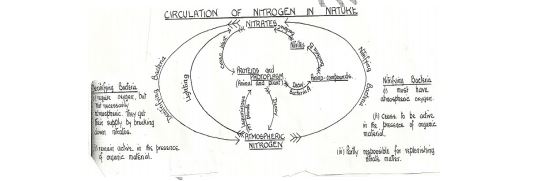
iii) Describe the nitrogen cycle
during thunderstorms/lightning nitrogen gas combines with oxygen to form nitrogen oxides
nitrogen oxides dissolve in water to form nitric acid
acid is deposited in the soil by rain
nitric acid combines with chemical substances to form nitrates or nitric acid dissociates to form nitrates which are absorbed by plants
symbiotic bacteria (Rhizobium) which are found in root nodules of leguminous plants fix free nitrogen to nitrates
free living bacteria (clostridium and Azotobacter) fix nitrogen to nitrates
nostoc algae (Anabaema chlorella) fix nitrogen to nitrates
plants use nitrates to form plant proteins
animals feed on plants and convert plant proteins into animal proteins
plants and animals die and are decomposed by putrefying bacteria, fungi(saprophytes)
decomposing plants, animals and nitrogenous wastes release ammonia which is converted to nitrites by Nitrosomonas and nitrococcus bacteria
nitrites are converted to nitrates by nitrobacter bacteria
nitrates in the soil can be converted to free nitrogen (denitrification) by some fungi, pseudomonas and theobaccilus bacteria generally called denitrifying bacteria
iii. Nitrogen in the atmosphere cannot be directly utilized by plants. State two ways by which this nitrogen is made available for plant use
fixation by microorganisms (Rhixobium, Axotobacter)
fixation by electrical discharge in atmosphere i.e. conversion by thunderstorm or lightning
f) i) Describe how energy flows from the sun through the various trophic levels in an ecosystem
energy from the sun is trapped by green plants during photosynthesis, producing chemical energy9food or carbohydrates
green plants are producers and occupy the first trophic level
green plants are eaten by herbivores called primary producers as they occupy the second trophic level
herbivores are eaten by carnivores, secondary consumers, which occupy the third trophic level
when organisms – plant and animals) die, fungi and bacteria which are saprophytic organisms feed on them thus causing them to decompose into simple substances e. g. mineral salts
these organisms are called decomposers and detrivores
decomposer feed on dead organic matter hence cause decomposition and decay which releases nutrients for plants, linking biotic and a biotic components
at all levels energy is lost through respiration
Give the reasons for loss of energy from one trophic level to another in a food chain
insufficient utilization of food resources(wastage) e.g by defalcation
through respiration
through excretion e.g. urination and sweating
Why are green plants referred to as primary producers in an ecosystem?
They utilize the energy from the sun to manufacture food for themselves and for subsequent trophic level (consumers) and other organisms
vi. Explain the following terms giving suitable examples
Food chain
a nutritional sequence between producers and consumers through which energy flows in a straight line i.e. linear representation of feeding relationship between different organisms in an ecosystem
if one consumer or the producer is removed the food chain is broken
arrow points to the direction of energy flow e. g. green plant herbivore carnivore decomposer

Food web
complex feeding relationship Where a on more than one type of food while several herbivores feed on one type of plant
it is an interrelationship of many consumers are usually fewer to ensure survival of both
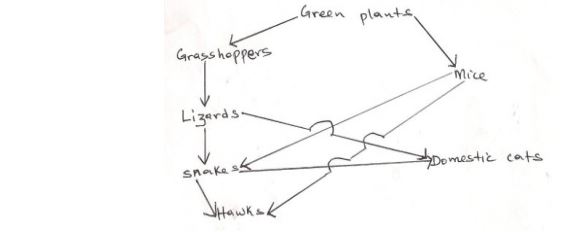
Pyramid of numbers

this is a diagrammatic representation of numbers of organisms at each trophic level in a food chain
usually there are more producers than consumers
hence producers herbivores carnivore
the reason for the pyramid is because herbivores feed on many plants (producers) as camivores feed on many herbivores
sometimes this may not be true e. g. when many caterpillars feed on one tree or parasites on a herbivore
this gives an inverted pyramid of numbers
Pyramid of biomass
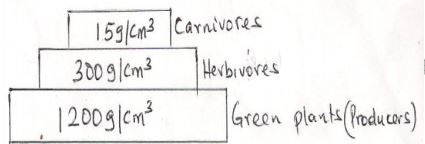
refers to diagrammatic representation total dry weight of organisms at different trophic levels in a food chain
producers have greater biomass than any level of consumers progressively
size of organisms in successive e trophic levels increases
amount of individuals decreases in successive levels
Account for the decrease of biomass in the successive trophic levels
fixed energy which supports living matter decreases at each successive trophic level since energy is lost by respiration and indigested (unconverted) materials hence less biomass supported at each level
h) i) Describe the three characteristics of a population growth
increase in numbers
decrease in numbers growth rate
change in numbers
Dispersion
spread or distribution of organisms in a habitat
Density
the number of individuals per unit area
ii) Explain how the following methods are used to estimate population of organisms
quadrat method
identify the study area
throw or mark out the quadrat in the area of study at random
identify or label the various species of plants in the quadrat
count plants of each species
record the numbers
repeat the process
work out the average per quadrat for each species
calculate the total number of different species in the area or calculate the population for the total area of habitat Q
Line transect
a string is stretched along an identified area
all plants touching the string are counted
Belt transect
preliminary study of the study area to estimate siie or make a sketch map
two parallel lines (strings or ropes) running for a determined distance and width
count the number of organisms in the transect
calculate the area covered by the transect
calculate the number of organisms being investigated per unit area
repeat this process at least three times in other parts of the study area
find the mean number of organisms per unit area from all the belt transects
from this figure calculate the total population of the desired organisms in the study area
Capture-recapture method
e.g. grasshoppers or fish
capture the grasshoppers
count and mark using permanent ink
record
release and allow time
recapture and count the marked and unmarked
total population is equal to the number of marked and unmarked grasshoppers in the second sample multiplied by the number of marked grasshoppers in the first sample divided by number of grasshoppers marked in the second sample that were recaptured
2. a) Describe the adaptations of plants to various habitats
i. Xerophytes
grow in areas with scarcity of water
roots grow deeply and extensively (widely spread) to ensure access to water
thick succulent stems, roots and leaves for water storage
photosynthetic stems take place of leaves which would lose a lot of water
Leaves are needle-like (reduced to spines), scaly, have sunken stomata. Some have curled (rolled) leaves. Some have thick waxy cuticle, reduced number of stomata to reduce water loss by transpiration
some shed leaves during dry season to reduce water loss
presence of thorns for protection
short life cycle to ensure survival
reversed stomatal rhythm
ii. Hyrophytes
grow in places with plenty of water(waterlogged)
aerenchyma a tissue (airspaces) and large intercellular spaces and long fibrous roots for buoyancy (floating in water)
poorly developed support tissues (sclerenchyma) because water provides the necessary support
upper epidermis of leaves have more stomata than lower epidermis for gaseous exchange or for increased rate of transpiration
poorly developed conducting tissues (xylem and phloem) because plants obtain water by diffusion
iii. Mesophytes
grow in well watered soils ‘(common plants)
no special adaptations, but depending on particular habitat, may have some adaptations
in forests they grow fast; tall to capture light. Have climbers while some are adapted to carry out photosynthesis in low light intensities (those that form undergrowth)
in places with adequate water they form broad leaves, thin cuticle and many stomata on both leaf surfaces
in direr regions they possess more stomata on the lower leaf surface and are deep rooted
some are shallow rooted and develop buttress and prop roots for support
some have waxy or glossy surface to reflect sun rays and drip off rain water
iv. Halophytes
plants that grow in very salty soil where the salt concentration is higher than that in the plant
have root cells which concentrate a lot of salts in them and enable then to take in water by osmosis
succulent roots to store water
have pneumatophores (breathing roots) to take in oxygen
some have buttress roots for support
secrete excess salt by use of salt glands
have large airspaces in leaves and stems for buoyancy and to store air
capable of photosynthesis at low light intensities e.g. mangrove
b) 1) What is pollution?
any process which leads to adverse or harmful changes in the environment
ii) Explain the various human activities that have caused pollution
Causes and effects of air pollution
sulphur iv oxide, hydrogen sulphide, chlorine, oxides of nitrogen produced by industries, sewage, decomposing organic matter and fumes affect gaseous exchange, makes acid rain and damage plant leaves
aerosols, herbicides, insecticides (agrochemicals), paint spays, acaricides and CFC’s sprayed to control diseases, pests and weeds affect respiratory organs of animals. The chemicals are residual and persistent (not easily broken down) and bring depletion of the ozone layer
smoke and fumes produced in areas withheavy industries, motor vehicles, fires which bum fuel, oil, wood and coal cause carbon ii oxide, poisoning affect respiratory systems and affect visibility
particles in smoke and fumes settle on leaves and stop photosynthesis
carbon iv oxide causes green house effect which causes temperature inversion as a result of heating the lower layers of atmosphere
sound and noise produced incessantly by machines, aeroplanes and heavy vehicles affect hearing in animals
dust from cement factories, quarries, dust roads settles on leaves limiting photosynthesis
removal of vegetation interferes with carbon cycle radio-active emissions from nuclear reactors, mines and bombs cause cancer, mutations and death.
Control of air pollution
use of lead free petrol in motor vehicles, air craft, aeroplanes and petroleum engines
uses of smokeless fuels and electricity
filtration, dissolution and use of chemicals to remove harmful gases
factories should be erected far away from residential areas
use of tall chimneys
reduce volume or intensity of sound e. g. by use of ear muffs
concords should fly at higher altitudes and aeroplanes to fly high up
State the causes, effects and methods of controlling and prop roots for support water pollution
Causes and effects
agrochemicals e.g. fertilizers cause eutrophication leading to increase in animal population
Silting makes water surfaces shallow and silt clogs stomata and gills of fish reducing rates of photosynthesis and gaseous exchange. It also leads to reduction of algae which causes reduction of consumers i.e. animal population
industrial and domestic wastes contain toxic materials which kill producers and other organism while oily substances in wastes may clog gills of fish and may change pH of water oxygen solubility is also reduced by oily surfaces
Untreated sewage and effluents where decomposition or organic matter in sewage reduces oxygen supply and sewage provides food for bacteria increasing their population and demand for oxygen thus depriving fish of oxygen.
Human feaces causes eutrophication, carbon IV oxide produced by decomposition of faecal matter changes pH of water interferes with photosynthesis and may clog fish gills or block light penetration which interferes with producers thereby decreasing productivity.
Dumping of chemicals from industries with toxic pollutants which kill organisms
Spillage of oil and chemicals block oxygen and kill organisms
Discharge of water from industries into water body where high temperatures reduce amount of oxygen in the water causing organism to suffocate and die
Untreated sewage may lead to outbreak of epidemics
Control of water pollution
pollution caused by domestic effluents may be controlled by treating domestic waste, using biotechnology, banning the use ofphosphate-based detergents, using plastic pipes instead of those made from lead, recycling gabbage, using biodegradable detergents.
Pollution caused by industrial waste may be controlled by treating/cooling industrial waste, carrying out environmental impact assessment before establishing industries
Oil spillage may be controlled by cleaning spilled oil biotechnology and penalizing the industry
individual or companies which cause oil spills/water pollution
Pollution caused by agrochemicals may be controlled by using mechanical control of weeds, biological control of weeds and pests, biodegradable organic fertilizer herbicides, insecticides pesticides, organic farming educate farmers on the use of correct amount of agrochemicals
silting may be controlled by appropriate farming practices, contour farming, reafforestation, building gabions and terracing
iv) State the causes /effects and control methods of soil pollution
Causes and effects
Air pollutants e. g. sulphur IV oxide fumes form sulphuric acid with rain water. The acid rain alters soil pH therefore affecting plants that cannot tolerate acidic soil
most aerosols sprayed to control pests and diseases precipitate in the soil and are taken up by plants which make its concentration many times higher, increasing the toxicity in the plants which absorb them
petroleum products due to spillage by oil tankers making it impossible for plant roots to obtain oxygen in oil saturated soils, therefore plants are killed
agrochemicals and inorganic fertilizers contain heavy metals that are not used up by plants and eventually soil microorganisms cannot inhabit the soils
organic matter slows down, life ceases and soil becomes exhausted
community, household wastes and industrial wastes disposal is a major problem in big towns and cities. commodities packaged in metal tins, rubber, plastic containers, scrap metal, glass bottles, different types of paper are nuisance to the environment, rendering it useless for agricultural purposes
Control of soil pollution
use of organic farming techniques _
biological control of pests, diseases, parasites
recycling of non-degradable containers or burying them safely after use
controlled burning of garbage
treatment of human and industrial waste for safe disposal
avoid spilling chemicals and oil when used
v) Define biological control give suitable examples
using a living organism to regulate, control or reduce the population of another organism e.g beetles to feed on water hyacinth, fish to feed on mosquito larvae.
vi) What is eutrophication?
enrichment of water bodies with nutrients due to discharge of sewage leading to rapid growth of surface plants
i) What are the effects of eutrophication?
enrichment of water bodies with nutrients due to discharge of sewage leading to rapid growth of surface plants
vii) What are the effects of eutrophication?
The plants block light from reaching plants underneath hence no photosynthesis The plants die and decompose leading to lack of oxygen hence animals also die
c) Describe the symptoms, mode of transmission and control of cholera, typhoid, malaria and amoebic dysentery in humans
Cholera
causative agent
Vibrio cholerae (bacterium)
Transmission
Contaminated food or water
Spread by flies from faeces
Symptoms
Intestinal pain
Diarrhea
Vomiting
Dehydration
Control
Proper hygiene e.g boiling drinking water
vaccination
Typhoid
Causative agent
salmonella typhi (bacterium)
Transmission
Contaminated food or water
Spread by flies from faeces
Symptoms
Fever
Rashes
diarrhea plus blood from bowels
Control
Proper hygiene e.g boiling drinking water
vaccination
Malaria
Causative agent
Plasmodium (protozoa)
Transmission
Bite by infected anopheles female mosquito
Symptoms
Fever
Joint pains
Vomiting
Headache
Anaemia
Control
Killing the mosquito
Killing the mosquito larvae
Draining stagnant water
Clearing bushes
Treatment
Sleep under mosquito nets
Amoebic dysentery (amoebiasis)
Causative agent
Entamoeba hystolytica (bacterium)
Transmission
Contaminated food or water due to improper faeces disposal
Symptoms
Intestinal pain
Diarrhea
Vomiting
Dehydration
Control
Sanitation
Personal hygiene
Cook food well
Treatment using drugs
d) Discuss Ascaris lumbricoides under the following sub-headings
i. Mode of transmission
through ingestion of contaminated food
live in intestines
ii. Effects of parasite on the host
inflammation of lungs
pneumonia
produce toxic substances
intestinal obstruction
iii. Adaptations
thick cuticle which protects it against digestion
lays many eggs to ensure survival
mouthparts for sucking partly digested food
lack of elaborate alimentary canal
tolerant to low oxygen concentration
two hosts to ensure survival
eggs have protective cover to ensure survival in adverse environments
iv. Control and prevention
proper sanitation
wash hand after defaecation and before eating
e) Discuss schistosoma under the following sub-headings
i. Mode of transmission
through contaminated water in swamps, etc
ii. Effects on host
bleeding in lungs
blood stained urine
unthriftiness
iii. Adaptations
has two hosts to increase chances of survival
eggs have a hook like structure which raptures the walls of intestine or bladder
lay large number of eggs to ensure survival
larvae have a sucker for attachment on human skin which it digests
larva has a tail which it swims with in search of host in water
prolonged association between male and female to ensure that fertilization takes place
adults can tolerate low oxygen concentration (in the animal tissues)
adult worm secretes chemicals against antibodies
larvae and eggs (have glands that) secrete lytic enzymes to soften the tissues that ease penetration
larvae are encysted so as to survive adverse conditions
Control and prevention
proper use of toilet facilities
boiling water before use
avoid bathing/washing in infected water
Use of molluscicides (chemicals that kill snails/biological control/clearing water weeds on which snails feed.
Drainage of stagnant water
Wearing gum/rubber boots
3. a) i) What is reproduction?
process by which living organisms give rise to new members of their own species which resemble the parents
ii) Why is reproduction important?
for continuity of speciesl to ensure survival of species
maintaining life of species
replace dead individuals
iii) Name the types of reproduction
sexual which involves fusion of male and female gametes
asexual in which no gametes are involved but parts of a mature organism develops into new individuals
b) i) What is cell division?
process by which cells are formed from pre-existing cells
ii) What are chromosomes?
Threadlike structures found in nucleus of a cell.
The units called genes
Genes are factors that cause inheritance or determine characteristics of offspring
c) i) What is mitosis?
A type of cell division that occurs during growth leading to increase in number of cells
all cells maintain the same chromosome constitution i.e. the diploid state
ii) Describe the five stages of mitosis
Interphase
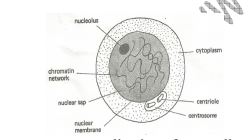
replication of organelles
duplication of DNA
production of energy (ATP) for cell division
Prophase
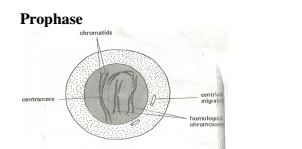
stage of dehydration
chromosomes shorten and thicken
chromosome replicates into two chromatids
chromatids joined at centromere
formation of spindle fibers
Metaphase
chromosomes move to equator (early metaphase)
chromosomes line up at the equator
homologous chromosomes do not associate
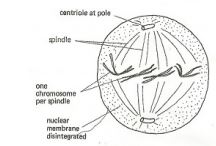
Anaphase
Chromatids separate
move to opposite ends (poles) of the cells
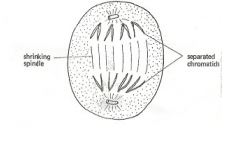
Telophase
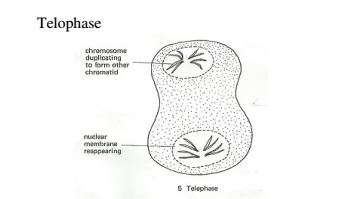
chromatids reach the poles
formation of two daughter cells occurs i.e. cytoplasmic division
ii) State the significance of mitosis
ensures each daughter cell has same number and kinds of chromosomes as daughter cells
gives rise to new cells (responsible for growth)
d) i) What is meiosis?
division of diploid cells to form gametes which are haploid
ii) State the significance of meiosis
gives rise to gametes
source of variation
iii) Give a summary of the stages of meioeis
First meiotic division
Interphase I
cell is in non-dividing condition
chromosomes appear threadlike

Prophase I
chromatic material shorten and thicken
double stranded chromosomes appear (bivalent)
double stranded chromosomes pair and twist round each other (synapsis)
point of contact of chromosomes is called chiasma
Metaphase I
paired homologous chromosomes line up at the equator
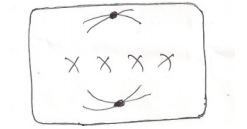
Anaphase I
paired homologous chromosomes move to the poles
Telophase I
paired homologous chromosomes reach the pores
two new nuclei are formed
Second meiotic division
Prophase II
chromosomes shorten, thicken and become visible,
stage of dehydration
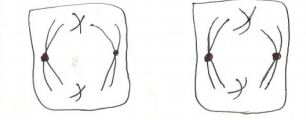
Metaphase II
movement of chromosomes to equator

Anaphase II
chromatids of each chromosome separate to the poles

Telophase II
reach the poles
four haploid daughter cells are formed

iv) Give the similarities between mitosis and meiosis
both take part in cells
both involve division (cell multiplication)
v) What are the differences between mitosis and meiosis?
Mitosis
maintenance of chromosome number (diploid)
take place in somatic cells/growth
no crossing over/no variation
results in to two daughter cells
no pairing/no synapsis/no bivalent formed
a one division process of four stages
meiosis
reduction halving of chromosomes (haploid)
occurs in reproductive cells/gonads/produces gametes
crossing over takes place/variation occurs
results in to 4 daughter cells
there is pairing/synapsis/bivalent
a two dicision process of four stages each
d) i) What is asexual reproduction
formation of new individuals as a result of the fusion of two gametes
fusion is called fertilization
ii) What is the significance of sexual reproduction in living organisms?
leads to genetic variation e. g. cross breeding which gives rise to hybrids
iii) State the advantages of sexual reproduction
genetic variation
greater adaptability to environment by offspring
few bad or good traits inherited/retained
greater amount of dispersal is possible
may result in stronger offspring
iv) Give the disadvantages of sexual reproduction
less certainty in egg and sperm meeting
low rate of survival
sex-linked diseases easily transmitted
e) i) What is asexual reproduction?
formation of new organisms without fusion of gametes
occurs with only one parent
parts of organism develop into new individual
ii) State the advantages of asexual reproduction
retention of useful characteristics/genes/traits
offspring establish faster/shorter life cycle
better chances of survival because of suitable environment
iii) Give the disadvantages of asexual reproduction
lack of genetic variation
lowered resistance to disease ~
loss of hybrid vigor
competition for resources due to overcrowding
iv) Explain how reproduction occurs by the following methods of asexual reproduction
Sporulation
formation of spores
spores are small haploid cells produced by plants
Spores give rise to new haploid organisms
includes moulds, ferns, bryophytes, pteridophytes
Budding
where an outgrowth arises from a parent and drops off to develop into a new organisms
hereditary material in the daughter cell and parent are exactly the same
occurs in organisms such as hydra, jelly fish, sea anemones, yeast and some fungi
Binary fission
a cell splits into two new cells of equal size
each daughter cell grows into anew organism
Occurs in organisms such as amoeba, euglena, paramecium, some fungi and bacteria.
f) i) What is a flower?
this is the reproductive structure which bears the reproductive pans of a plant
it produces seeds and fruits
ii) Draw a longitudinal section of a labeled diagram of a flower
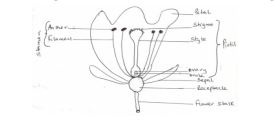
iii) Give the functions of the parts of a flower
Receptacle
expanded end of stalk which bears floral parts
Calyx
consists of sepals
usually green
protect flower in bud
Corolla
consist of petals
often colored or scented to attract insects
Androecium
male part of flower
consist of stamens
each stamen consists of an anther containing pollen sacs
anther produces pollen grains which contain male gametes
Gynaecium
female part of flower
consists of one or more carpels
each carpel contains one or more ovules in an ovary
style bearing a stigma extends from ovary
ovary contains female gametes which when fertilized become seeds
iv) What is inflorescence?
a group of flowers borne on the same branch (main stalk)
v) Explain the meaning of the following terms which describe flowers
Hermaphrodite
one with both stamen and carpel
most flowers are hermaphrodite/bisexual
Unisexual
have only one of carpel or stamen i.e. either male or female
Carpelate
also called pistilate
contains only carpels hence a female flower
Staminate
also called male flower
contains only stamens
Dioecious plants
have pistilate and staminate flowers on different plants e.g. pawpaw
Monoecius plants
have pistilate and staminate on one plant
however, pistilate and staminate occur at different plants e. g. maize
Complete flower
Has all four parts i.e. Calyx, corolla, androecium and gynoecium
Incomplete flower
does not have all four parts
at least one is missing
vi) Explain the meaning of the following types of ovary
Superior Q ovary occurs above other floral parts on the receptacle Inferior (epigynous) Q other floral parts arise above ovary on the receptacle
g) i) What is pollination?
transfer of pollen grains from anther of a stamen to stigma of a flower
ii) Explain the types of pollination
self pollination takes place when mature pollen grains of a flower fall on the stigma of the same flower
cross pollination takes place when pollen grains of a flower fall on the stigma of another flower of the same species
iii) State the advantages of pollination
healthy offspring
leads to variation
greater chances of dispersal
iv) List the agents of pollination
wind
water
insects
v) How are flowers adapted to wind and insect pollination?
Insect pollinated flowers (entomophilus)
are scented to attract insects
have stick stigma for pollen grains to stick on
are brightly coloured to attract insects ,
presence of nectar to attract insects
have nectar guides to guide insects to the nectarines
have nectarines to secrete nectar
stigmal anthers located inside the flower/tubal/funnel shaped corolla to increase chances of contact by insects
sticky/spiny/spiky pollen grains which stick on the body of insects and on stigma
large/conspicuous flowers easily seen by/attract insects
anthers firmly attached to the filament for insects to brush against them
landing platform to ensure contact with anthers and stigma
mimicry to attract (male) insects
Wind pollinated flower (anemophilus)
anthers/stigma hang outside the flower to increase chances of pollination
the style/filament is long to expose stigma/anthers
stigma is hairy/feathery/branched to increase surface area over which pollen grains land/to trap pollen grains
pollen grains are smooth/dry/light/small to be easily carried by wind
large amount of pollen grains to increase chances of pollination
anthers loosely attached to filaments to enable them to sway to release pollen grains
pollen grains may have structures which contain air to increase buoyancy
flowers have long stalks holding them out in the wind
vi) State the Ways in which plants prevent self-pollination
protandry(anthers/stamens mature first)
protagyny (pistils mature first)
monoecism (where male and female parts are on same plant but different parts)
dioecism(where male and female parts are on different plants)
incompatibility (self sterility)
heterostyly (styles at different heights)
vii) Give the characteristics that ensure cross pollination takes place in flowering plants
presence of special structures that attract agents of pollination
protandry/dichogamy
protagyny/dichogamy
monoecism
self sterility
heterostyly
viii) State the advantages of cross pollination
hybrid vigour
less prone to diseases
promotes genetic variation
greater evolutionary potential
h) i) What is fertilization?
Fusion of male and female gametes to form a zygote
ii) Describe how fertilization takes place in a flower
this follows pollination
pollen grain is deposited on the stigma
pollen grain sticks to the surface of the stigma
the surface of the stigma produces a chemical substance which stimulates the pollen grain to produce a pollen tube/to germinate
the pollen tube grows through the style tissues on which it feeds until it enters the ovary
the generative nucleus divides into two giving two male nuclei
embryo sac contains eight nuclei i.e. two synergids, egg cell, two polar nuclei and three antipodal cells
the pollen tube enters the embryo sac through the micropyle and one of the male nucleus fuses with the egg cell/ovum to form a zygote
the other male nucleus fuses with the two polar nuclei to form the triploid nuclei/endosperm)food storage used by developing embryo)
the pollen tube nucleus in the pollen tube disintergrates soon afterwards
this process is referred to as double fertilization
zygote grows into an embryo containing plumule, radicle and cotyledons

iii) What is double fertilization?
there are two male nuclei entering embryo sac
one fuses with the ovum to form a zygote, while the other fuses with the polar nuclei to form a triploid primary endosperm nucleus
therefore there are two fusions at fertilization
iv) Name the changes that Occur in a flower after fertilization
petals, stamen, calyx and style wither
ovary wall changes into pericarp
intergument changes in to seed coat/testa
zygote changes into embryo ‘(by mitosis)
primary endosperm nucleus changes into endosperm
whole ovule changes in to seed
ovary develops and grows into fruit(under the influence of gibberrellic hormone)
b) i) Distinguish between a fruit and a seed
a fruit is a fertilized ovary and has two scars
a seed is a fertilized ovule and has one scar
ii) How is a seed formed?
after fertilization, zygote grows into an embryo, primary endosperm nucleus developed into endosperm, interguments harden to form testa, hence the whole ovule becomes the seed
the seed loses water to become drier
the seed has plumule, radicle, seed leaves called cotyledons, a microphyle and a scar
iii) Draw a labeled diagram of a seed

iv) Describe the main parts of a seed
Testa
also called seed coat
a tough outer covering which protects the seed from insects, bacteria etc
segment is the membrane inside the testa
Hilum
a scar
spot where the seed was attached to the fruit or pod
Micropyle
small hole through which water and air enter the seed
Radicle
embryonic root
grows into the shoot system
Cotyledons
embryonic leaves
store food for the germinating seed i.e. for plumule and radicle
when plumule and radicle grow, they use food stored in the cotyledon
in some seeds food is stored in the endosperm
v) Draw a labeled diagram of a fruit
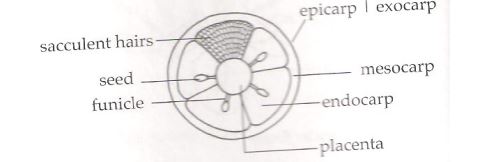
vi) How is a fruit formed?
one of the organs that remains on the plant after pollination and fertilization is the ovary
within the ovary, the developing embryo produces special chemical substances that stimulate the young ovary
these substances also signal the start of the formation of the fruit, which is a mature ovary
the fruit may contain one or more seeds
during fruit formation the ovary increases in size while ripening or maturing
a true fruit is formed from the ovary of a flower after fertilization
it has two scars(style scar and stalk scar) and contains seeds
some seeds are not formed from the ovary of a flower
some other parts of a flower develop to form a fruit
such fruits are called false fruits
vii) Explain the importance of fruits in the survival of plants
protect the seed against dessication, predators and adverse conditions
aid in seed dispersal by attracting agents of dispersal
stores food for the plant
vii. Distinguish between parthenogenesis and parthenocarpy
parthenogenesis is development of new animals from unfertilized eggs
paithenocarpy is development of a fruit without fertilization
iv) state the differences between a seed and a fruit
A Seed
fertilized ovule
attached to the placenta through funicle
one scar called hilium
has seed coat/testa
seed wall undifferentiated
fruit
fertilized ovary
attached to branch through a stalk
two scars (style scar and stalk scar)
has fruit wall/pericap
fruit wall is differentiated
j. i) What is placentation?
arrangement of ovules within the plant ovary
ii) Explain the following types of placentation
Marginal

placenta appears as one ridge on ovary wall
ovules are attached to placenta in rows e. g. peas in a pod
Basal

placenta formed at the base of the ovary With numerous ovules attached to it
Parietal
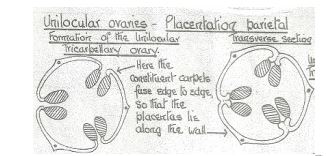
edges of carpels fuse together
dividing Walls disappear, leaving one
have numerous seeds e. g. passion fruit
placenta of each carpel appears as ridge on ovary Wall
Axile
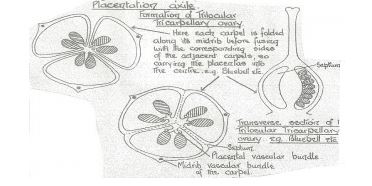
edges of carpels fuse together to form a single central placenta
numerous ovules arranged on placenta
ovary divided into a number of loculi by walls of the carpel e. g.
Free central placentation
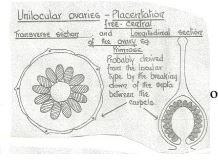
edges of carpels fuse together
dividing was disappears leaving one loculus
placenta appears at base of ovary
has numerous ovules
c) i) How are fruits grouped?
Simple fruits
formed from a single flower or one ovary e. g. mango
Aggregate fruits
consists a group of ovaries that appear on a common receptacle e. g. strawberry
Multiple (compound) fruits
formed from several flowers whose ovaries fuse together after fertilization
form a bunch e. g. pineapple, figs
are always false fruits
ii) What are succulent fruits?
also called fleshy fruits
all or part of pericarp (fruit wall) becomes juicy
iii) Give types of juicy fruits
Berry
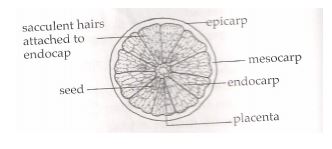
has many seeds
whole pericarp is succulent e. g. orange, tomato, pawpaw
Drupe
only one seed
pericarp divided into three layers i.e. epicarp, mesocarp(juicy) and endocarp(hard) eg mango and coconut
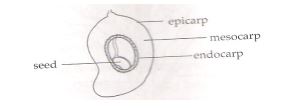
Pome
juicy part is swollen receptacle
is usually a false fruit
example is a pear
iv) What are dry fruits?
have a pericarp that is dry, hard and Woody
either dehiscent or indehiscent
called dry because they are not succulent
v) What are dehiscent fruits?
split open when ripe to release seeds
contain many seeds
vi) Give types of dehiscent fruits
Legumes
split along two edges
are usually pods e.g. beans, peas, crotolaria
Follicle
split on one side only e. g. Sodom apple
Capsule
has several lines of Weakness/sutures
open in many places e.g. castor oil, cotton
vii) What are indehiscent fruits?
non-splitting fruits
usually one seeded only
ii) Give main types of indehiscent fruits
Nut
pericarp woody, hard and thick e.g. cashew
Achene
has thin, tough pericarp e.g. sunflower
d) i) What is seed and fruit dispersal?
spreading of seeds and fruits away from parents so as to settle where conditions are suitable for their germination
ii) Why is dispersal of seeds and fruits necessary?
prevent overcrowding
reduces competition for space, nutrients and light
colonization of new areas is made possible
to increase chances of survival
to prevent inbreeding
to avoid extinction due to over competition for the necessities
iii) Explain how seeds and fruits are adapted to various methods of dispersal
Adaptations for wind dispersal
they have wings, feathers or hair-like structures to increase surface area for wind to carry them easily/buoyancy
seeds/fruits are loosely attached on the stalks so that they can easily be released and carried away by wing
seeds/fruits are generally light and small sized to be easily carried by wind
some seeds/fruits have parachute-like structures to be easily carried b wind
some have censor mechanism where seeds and fruits are borne on long stalks that are loosely attached which allows swaying so that movements of capsule by wind releases the seeds
Water dispersal seeds
seed mesocarp has air spaces thus light/buoyant to float hence carried by water
they have waterproof cover and tough pericarp protects seeds from getting soaked
fibrous and spongy mesocarp to easily float
Animal dispersal seeds
presence of hooks for attachment to animals thus carried to other parts
fruits are brightly coloured, succulent and scented to attract animals
seed coats are hard and resistant to digestive enzymes hence seeds are dropped away from mother plant
large in size or borne on clusters to be easily seen
Self dispersal/explosive
self opening seeds
they have lines of weakness called sutures for violent opening thus scattering seeds away from parent plant
5. a) i) Distinguish between external and internal fertilization in animals
in external fertilization fusion of the male and female gametes takes place outside the body of the female e. g. amphibians and fish
in internal fertilization union of gametes occurs inside the body of the female
ii) State the advantages and disadvantages of external fertilization
Advantages
large numbers produced therefore many offspring per breeding season
female does not suffer gestation stress
mother does not need to care for the young except in a few species
the surviving individuals are highly selected for better survival
Disadvantages
many predators surround the eggs before and after fertilization
fewer chances of fertilization/a lot of gametes wasted
embryo development at mercy of environment
large numbers of female gametes are required therefore female gets much exhausted
iii) State the advantages and disadvantages of internal fertilization
Disadvantages
number of gametes fewer hence less number of offspring
less adapted for sudden change of environment after birth
in mammals females suffer gestation stress
Advantages
more chances of fertilization
fewer predators of oval/fertilized egg protected in females body
Stable internal environment
fewer gametes required
iii) Give a reason why it is necessary for frogs to lay many eggs
to increase chances of survival/fertilization
iv) Compare external and internal fertilization


b) i) Draw and label the human male reproductive system
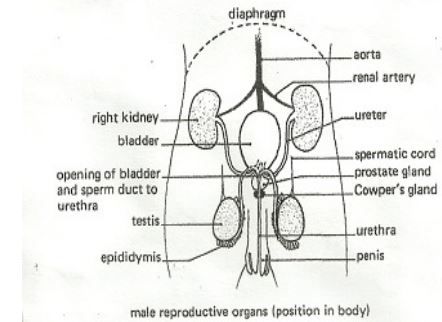
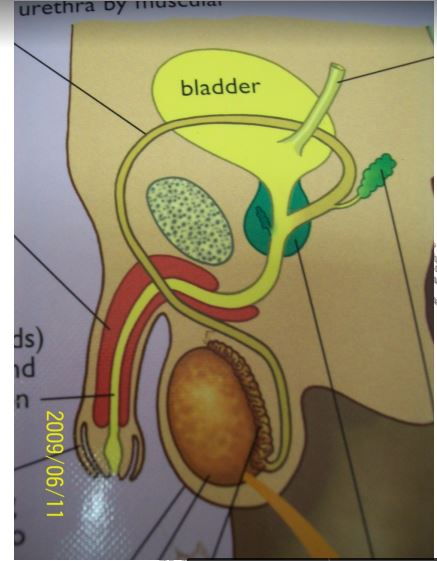
ii) Describe how the mammalian male reproductive system is adapted to perform its functions
Penis
is highly vascularised/spongy
has a sensitive glands
becomes erect to allow entry into the vagina
Scrotum
contains the testes outside the body on whose walls the process of spermatogenesis takes place
the process is favored by lower temperature
it contains sertoli cells which nourish sperms until they are mature
Epididymis
long and coiled for the purpose of sperm storage
Vas deferens
muscular
upon contraction pushes sperms out and allows ejaculation
Gametes
produced in large numbers to increase chances of fertilization
the sperms have a tail for swimming/large number of mitochondria to provide energy/allow swimming to reach the egg
Accessory glands
are seminal vesicle, Cowper’s gland and prostate gland
they produce seminal fluid to provide a medium/nutrients for sperms to swim
iii) How is the sperm adapted to perform its function?
acrosomes contain enzymes to digest egg membrane
nucleus contains genetic material
mitochondria produce energy to move the tail back and forth the lashing movement of the tail enables the sperm to move/propulsion in fluid medium towards the egg
it is streamlined for faster/easier movement/swimming to meet the egg
c) i) Draw and label the human female reproductive system
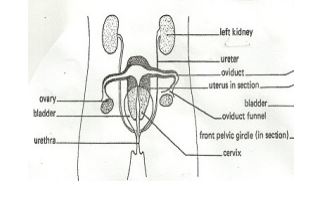
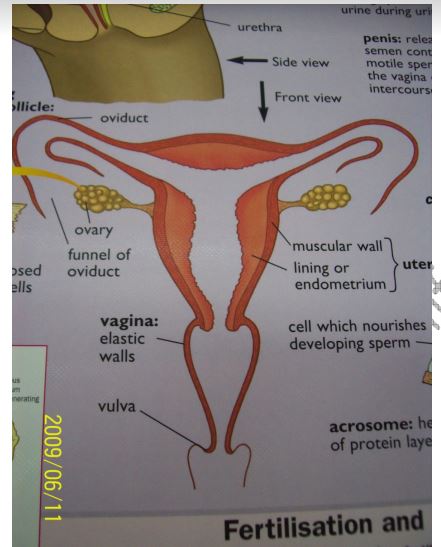
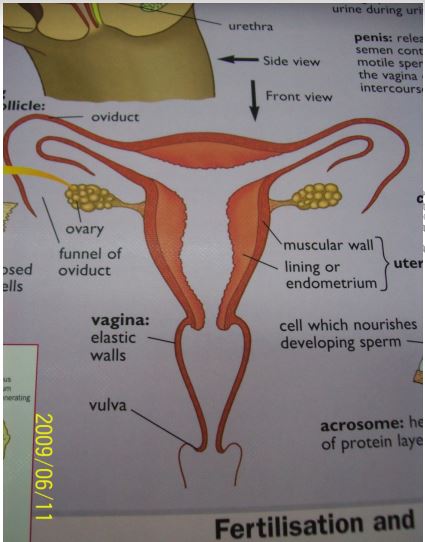
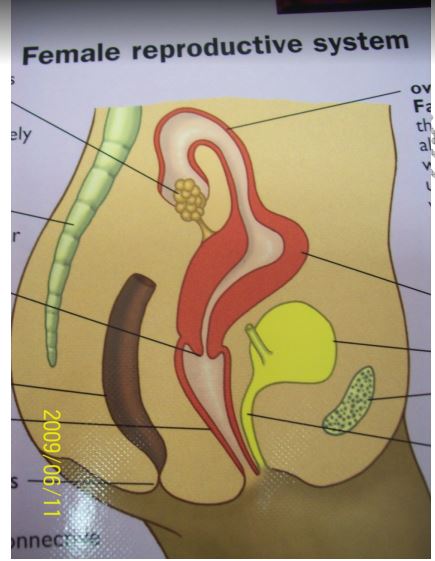
ii) Describe how the various structures of the human female reproductive system are adapted to their function
Ovaries
have several graafian follicles that develop and burst open to release/produce mature ova
secretes sex hormones(oestrogen) which initiate/control development of secondary sexual characteristics
produce hormones oestrogen and progesterone which prepare the uterus for implantation and subsequent nourishment of the embryo
Oviducts (Fallopian tube)
are thin narrow and tubular to increase flowing speed of semen containing sperms
are funnel shaped on the end next to ovary which enables them to receive the ovum
their lining contains cilia which propel the ovum towards the uterus
has peristaltic muscles that enable movement of zygote/ovum to the uterus for implantation
is fairly long to increase surface area for fertilization
Uterus
is muscular for protection of developing embryo
has elastic wall that allows growth and development of foetus/embryo
has a highly vascularised endometrium that provides nutrients/gaseous exchange to developing embryo
Cervix
has valves that close the lower end of the uterus to ensure continued pregnancy during gestation period
is capable of dilating ~
has narrow entrance/neck-like entrance to uterus that enables quick swimming of sperms to uterus
has suction mechanism that draws up/pulls sperms into uterus
has a “W” shape that fits well with the glands of the penis to ensure sperms are deposited at the right point
Vagina
is elastic and muscular to enable good accommodation or penetration of the penis thus proper deposition of sperms and for easy parturition
allows menstrual flow
has sensitive labial walls which secrete/produce lubricating substances that
ensure/enable/facilitate good coition
capable of considerable enlargement, due to elastic muscles, to accommodate baby during parturition
Clitoris
has sensitive cells for orgasm
iii) Explain how the ovum is adapted to its function
nucleus contains genetic material
ventelline membrane encloses plasma membrane which encloses yolky cytoplasm
yolky cytoplasm provides nourishment
jelly coat protects ovum against dehydration
iv) Explain the differences between sperm and ovum

d) i) Explain the process of fertilization
a process whereby the egg and sperm are brought together and fuse to form a zygote
occurs in the fallopian tube after copulation
sperm head penetrates the outer coat of the ovum While the tail remains outside
penetration is due to reaction of acrosome
acrosome digests the vitelline membrane
thereafter a zygote is formed
zygote which is diploid undergoes rapid cell division to form a mass of cells called blastocyst
after fertilization a membrane forms around the ovum to prevent further entry of sperms
blastocyst eventually develops into an embryo
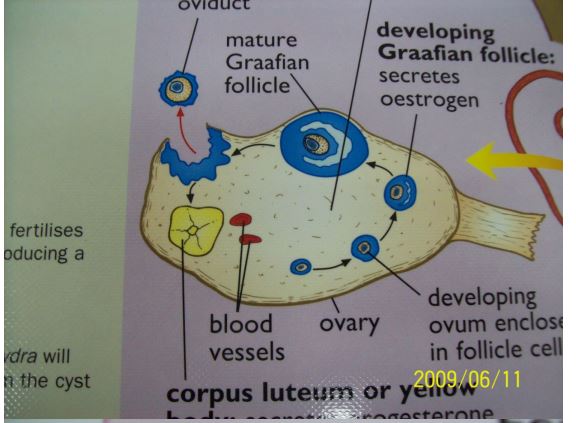
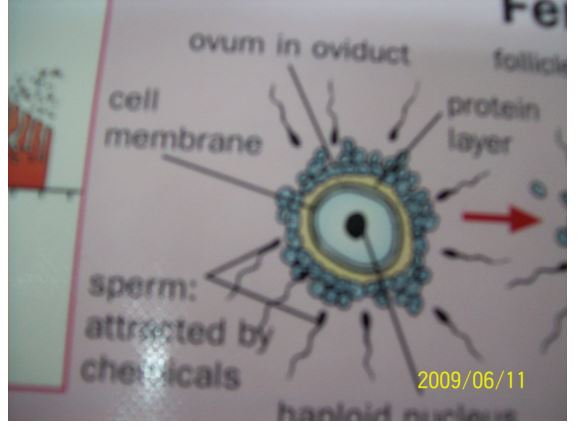
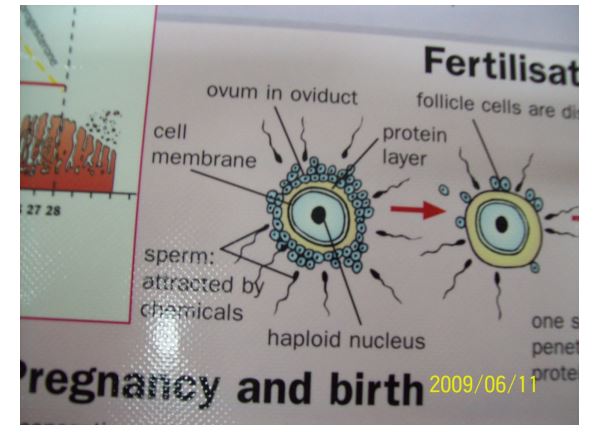
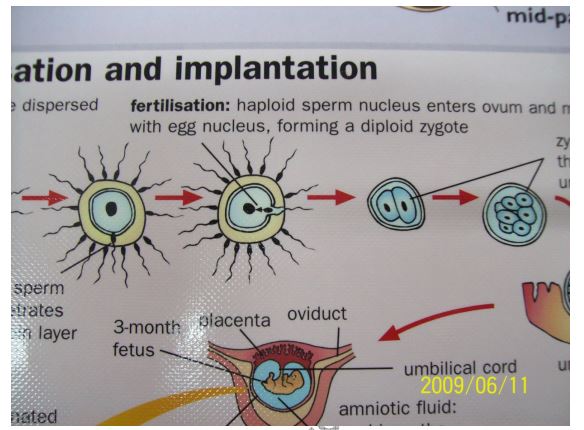
i) Explain the process of implantation
this is the embedding and attaching of the embryo in the uterine wall/endometiium
implantation marks the beginning of pregnancy
sometimes implantation occurs in the oviduct Wall which is abnormal and results in ectopic pregnancy which is fatal
the outer wall of the blastocyst develops finger like projections which project into the uterine wall for attachment
the projections are called villi
the villi and endometrium develop into an organ that is called the placenta
the embryo is attached to the placenta through a cord called the umbilical cord
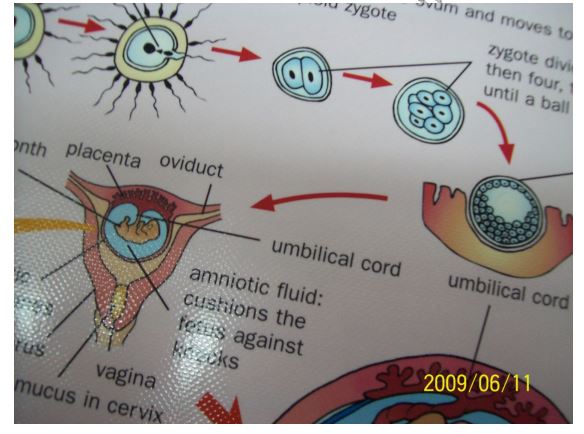
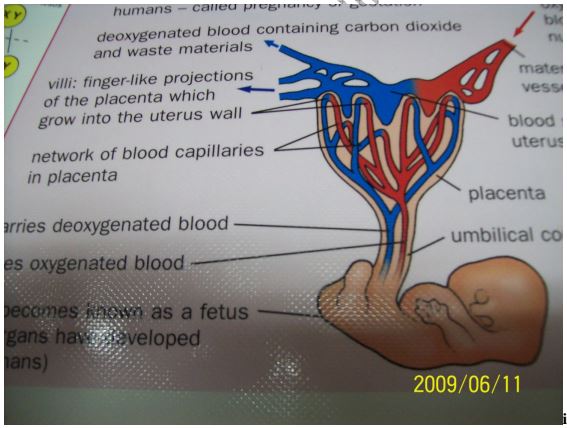
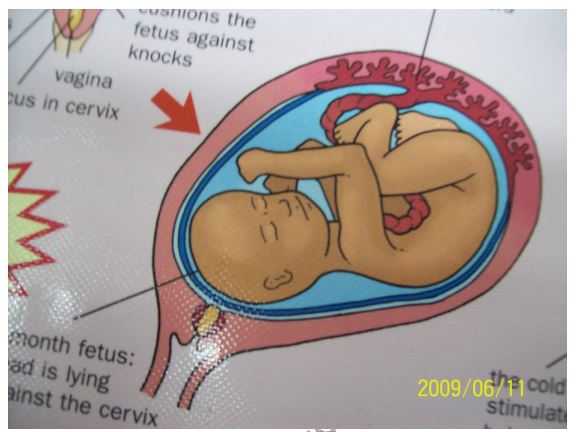
State the functions of umbilical cord
it contains blood vessels umbilical artery, iliac arteries and umbilical veins)
it joins the placenta to the embryo
passage for nutrients other
passage of excretory substancess from foetus to mother for final discharge
gaseous exchange
passage of antibodies from mother to foetus, for protection of foetus against diseases
State the role of placenta
exchange of gases between mother and foetus
exchange of nutrients and nitrogenous wastes
anchorage/attachment of foetus
produces hormones (oestrogen and progesterone)
e) i) What is gestation period?
time taken from fertilization to birth/pregnancy
ii) Explain the functions of the membranes associated with placenta
Chorion
surrounds the embryo
has fingerlike projections that attach embryo to the uterus
Amnion
contains amniotic fluid
fluid surrounds embryo
protects embryo from mechanical injury by acting as shock absorbers
fluid also protects embryo from dehydration
distributes pressure equally over embryo
Yolk sac
surround the yolk
produces blood cells for embryo until its own liver is able to perform the task
Allantois
present only for a short time
removes and store waste material
it eventually becomes the umbilical cord
iii) Explain the events that take place to facilitate parturition
near birth the placenta produces less progesterone
oxytocin hormone is produced by posterior lobe of pituitary gland
because progesterone level has decreased the uterus becomes sensitive to oxytocin
oxytocin causes the contraction of the uterus (myometrium)
these contractions are called labour pains
just before parturition the head turns downwards
the contractions eventually push the baby through the vagina
amnion breaks and amniotic fluid is released
oxytocin dilates the cervix
foetus is expelled through cervix with head coming out first
finally the whole infant comes out
the umbilical cord is cut and the placenta is expelled as afterbirth
iv) State the reasons why later in pregnancy the ovary will b e removed without disturbing the pregnancy
corpus luteum in the ovary secretes progesterone which maintains pregnancy and development of foetus after conception
after four months pregnancy is maintained by progesterone from the placenta
f) i) What are secondary sexual characteristics
Characteristics (physiological and anatomical) that start developing at puberty due to the influence of male and female hormones
ii) State the main secondary changes in
Boys
deepening of the voice
growth of hair on face, pubic part, chest, legs
penis and testes become bigger
muscular development
sperm production begins at puberty and may continue throughout life
Girls
growth of hair on pubic part and armpits
widening/enlargement of hips
development of breasts
menstrual cycle starts as ovaries mature
body acquires extra fat
iii) Describe the role of hormones in secondary sexual characteristics in
Boys
Follicle stimulation hormone (FSH)
from pituitary
stimulates production of androgens(male hormones) mainly testosterone by testis
Testosterone
secondary sexual characteristics
Girls
FHS
from pituitary
development of follicles
stimulates oestrogen production by ovary
LH
from pituitary
ovulation
stimulates release of progesterone by ovary
Oestrogen
stimulates release of LH
secondary sexual characteristics
Progesterone
also from placenta
sustains pregnancy as it inhibits prolactin and oxytocin during pregnancy
Prolactin
milk formation
Oxytocin
parturition
milk ejection
g) i) What is menstruation?
vaginal discharge due to disintegration of endometrium
ii) Describe the role of hormones in the human menstrual cycle
it is controlled by sex hormones which are responsible for the onset of secondary sexual characteristics and also control of the menstrual cycle
the onset is signaled by discharge of blood/menses 14 days following the start of menstruation
anterior lobe of pituitary gland secretes follicle stimulating honnone(FSH)
Follicle stimulating hormone causes graafian follicle to develop in the ovary. It also stimulates tissues of the ovary/wall (theca) to secrete oestrogen
oestrogen causes repair/healing of uterine wall
oestrogen stimulates anterior lobe of pituitary to produce luteinising hormonge (LH)
LH causes ovulation. It also causes graafian follicle to change into corpus luteum. LH stimulates corpus luteum to secrete progesterone
Progesterone causes proliferation/thickening of uterine wall
Oesterogen/progesterone inhibits, the production of FSH by anterior lobe of pituitary, thus no more follicles develop and oestrogen production reduces
In the next two weeks progesterone level rises and inhibits production of LH from anterior lobe of pituitary“
The corpus lutetium stopssecreting progesterone and menstruation occurs when the level of progesterone drops
Anterior lobe of pituitary starts secreting FSH again.
iii) What is menopause?
end of ovulation in women
occurs after age of 45 years
does not occur in males
h) Explain the symptoms, methods of transmitting and prevention (control) of the following sexually transmitted diseases
i) Gonorrhea
caused by a bacterium called neisseria gonorrhea
transmitted through sexual intercourse,
infects urethra and vaginal tract (epithelia)
Symptoms include pain, discharge of mucus and bad smell (females)
Effects include sterility, heart diseases, blindness of foetus and arthritis
Treatment by antibiotics
Control and prevention by proper sexual conduct
ii) Herpes
notably Herpes simplex and H. genitalis
caused by virus which attacks genitalia
symptoms are painful sores in genitalia, skin lesions
transmitted in saliva, sexual intercourse and injection by drug addicts
no treatment
iii) Syphilis
caused by bacterium called Treponema palladium
symptoms are painless wounds in genitalia
attack genitalia, nervous system, lips
treated by antibiotics
iv) Trichomoniasis
caused by plasmodium called trichomonas
attacks reproductive tract
symptoms are itching and discharge of pus from the genitals
treated by antibiotics
v) Hepatitis
Viral disease
Affects the liver
Transmitted through sexual intercourse
No known treatment
vi) Candidiasis
caused by fungus called candida albicans
transmitted through sexual intercourse
symptoms include itching urethra, and vaginal discharge (odourless)
controlled by personal hygiene, early treatment and responsible sexual behavior
vii) HIV/AIDS
caused by HIV virus
transmitted by sexual intercourse, blood transfusion, sharing piercing instruments from infected mother to foetus, infant and baby
symptoms include fever, swollen lymph nodes, night sweating, cough, weight loss, fatigue, loss of appetite, diarrhea, headache, a opportunistic infections and tumors
Control by responsible sexual behaviour, education, screening blood for transfusion and using sterile piercing instruments.
6. a) Define the terms
i) Growth
an irreversible change in size of a cell, organ or whole organism
growth is due to synthesis of protoplasm or extracellular substances
ii) Development
refers to a series of changes which an organism goes through in its lie cycle
during development both qualitative and quantitative changes take place(involves differentiation)
iii) Differentiation
refers to changes in which the cells of the body undergo and become specialised to perform specific functions
b) i) Differentiate growth in plants and animals

More differences between Plant Growth and Animal Growth
Plant Growth:
1. Growth continues throughout the life of the plant.
2. Here the growth involves increases in the number of parts.
3. Growth take place during definite seasons.
4. Growing pattern is distinct each species.
5. Plant possess well-defined growing regions.
6. A seedling does not resemble an adult plant.
7. A juvenile stage with distinct may be present in the life-history of a plant.
8. Growth is by addition of new parts ahead or around the older ones.
Animal Growth:
1. Growth takes place for definite periods before maturity.
2. Here it does not involve increase in the number of parts.
3. Each species has a distinct season for growth.
4. Growing pattern is absent.
5. They have no such defined growing regions.
6. The young one are identical to adults except in the body size and sexual maturity.
7. A juvenile stage with different morphology does not occur in higher animal.
8. Growth is diffused by all round increases in different organs of the body.
ii) List the processes involved in growth
assimilation
cell enlargement
cell division(by mitosis)
iv) List the parameters used to measure growth
height/length
dry Weight
number of individuals
volume
leaf area of plant
iv) Name the patterns of growth in organisms
allometric and isometric
limited and unlimited
discontinuous growth
c) i) Name the different types of growth curves
sigmoid curve(normal growth curve)
intermittent growth curve
ii) Draw a sigmoid growth curve and explain its different phases/stages
A-lag phase
– Slow growth rate at first
Organism adapting to the environment
B-exponential phase
– organisms already adapted
– first growth due to birth rate that is higher than death rate
C- Stationery phase (plateau)
– Birth rate equals death rate (equilibrium)
Lack of nutrients, accumulation of toxic waste products
D-phase of decline
– due to depletion of nutrients, accumulation of toxic wastes, lack of space
– some individuals old hence not reproducing
– death rate higher than birth rate
iii) Draw an intermittent curve and explain the various stages
A-growth
B-no growth
C- moulting/ecdysis
– seen in arthropods
– growth in in arthropods is intermittent(takes place during some time only because their hard cuticles (exoskeleton) does not expand to cause growth
– the cuticle must be shed off first to allow further growth
– the shedding is called ecdysis or moulting
– when moulting has taken place animal grows but growth stops when the exoskeleton hardens again
d) i) What is seed dormancy?
– A state where a viable seed is incapable of germinating when all conditions are favorable.
ii) State the biological importance of seed dormancy
– gives embryo time to reach maturity
– gives time for dispersal
– allows plant to survive adverse conditions
iii) State the factors which cause seed dormancy
Internal factors
– presence of abscisic acid/ABA/ presence of germination inhibitors
– embryo not fully developed
– absence of hormones/enzymes/inactivity of hormones/enzymes/gibberellins/cytokinins
– impermeability of seed coat
External factors
– unsuitable temperature
– absence of light
– lack of oxygen
– lack of oxygen
– lack of water
iv) Give the conditions necessary to break seed dormancy
– scarification/scratching to make seed coat impermeable
– vernalisation/cold treatment in some seeds like wheat
– burning/nicking/expose to heat e.g. wattle seeds
– destruction of germination inhibitors
e) i) What is seed germination?
– process by which a seed develops in a seedling
ii) What is viability
– ability of a seed to germinate
iii) Discuss the various conditions necessary for the germination of seeds
Water
– medium for enzymatic activity
– hydrolysis of food into simpler substances
– medium of transport
– softens the seed
– acts as a solvent
Air
– in form of oxygen
– oxygen is used for respiration/oxidation of food to release energy
Suitable (optimum) temperature
– activates enzymes involved in mobilization of food reserves
Enzymes
-breakdown and subsequent oxidation of food
– conservation of hydrolyzed food products in to new plant tissues
Viability
– only viable seed are able to germinate and grow
iv) Name and describe the types of germination
Epigeal
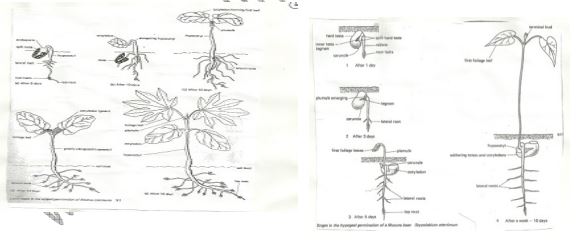
cotyledons are brought above the ground level during germination due to elongation of the bean seed that elongates to bring about epigeal germination
Hypogeal
– the cotyledons remain below the surface during germination due to elongation of epicotyl e.g maize
vi) Account for the loss in dry weight of cotyledons in a germinating bean seed
food stored is mobilized/used up for respiration and growth
vii) Describe the physiological changes that occur in a seed during germination
in presence of oxygen, optimum temperature and water, food reserves in the seed are hydrolysed or broken down into soluble diffusible form by enzymes
soluble food diffuses to the growing embryo
oils and carbohydrates provide energy
simple sugars converted to cellulose to form cell wall
amino acids make protoplasm
seed develops plumule and radicle hence germinates
viii) Explain the biological significance of cotyledons being brought above the ground in epigeal germination
cotyledons have inadequate food
they are brought above the ground to acquire chloroplasts to carry out photosynthesis
before the formation of foliage leaves to supplement food supply required for growth during germination
f) i) Distinguish between primary and secondary growth
Primary growth
occurs at the apical (shoot and tip) apices regions where meristematic cells occur
causes plant elongation since cells divide by mitosis
Secondary growth
occurs at the cambium meristems
Increases width (girth) of the stem
ii) What are meristems
dividing cells
meristem means they are dividing
iii) State the characteristics of meristematic cells
dense cytoplasm
thin cell walls
absence of vacuoles/cell sap
iv) State the location and function of the following meristematic tissues
Apical meristem
located at tips of roots and shoots
increase length of stem and roots/primary growth
Intercalary meristem
found at bases of internodes
responsible for elongation of internodes and increase in leaf sheath in grasses
Lateral meristems
found near the periphery of stem and root
responsible for secondary growth/growth in girth of stem and root/lateral growth
called cambium and constitute vascular and cork cambium
v) Describe primary growth
occurs at tips of shoots and roots in the meristematic tissues of apical meristem
at the apex there is a zone of cell division/mitosis
cells elongate at elongation zone
the elongated cells differentiate at the region of differentiation resulting in increase in size
in the stems meristems give rise to leaf premodia which envelop the apex to form a bud
the bud protects the delicate inner cells
in roots the meristem is protected by root cap
after cells differentiate the form permanent tissues
vi) Describe secondary growth in plants
also called secondary thickening ‘
only occurs in dicotyledonous plants that have cambium
monocotyledonous plants do not undergo secondary growth because they lack intervascular cambium
cambium cells divide to produce more cells on either side of the cambium
cells produced to the inside become secondary cambium
cells produced to the outside become secondary phloem
division of cambium cells occurs yearly producing new rings of secondary phloem and secondary xylem each year
intervascular cambium(cambium between vascular bundles) divide to form secondary parenchyma, thereby increasing growth of medullary rays
much more xylem is formed than phloem, thus pushing phloem and cambium ring outward
the rate of secondary growth is depended on seasons(rains) resulting in annual rings
cork cambium is located beneath epidermis ad is responsible for secondary thickening of the bark of perennial plants
cork cambium divides to form new cork(bark) tissues to accommodate increased growth on outside and secondary cortex on the inside
Cork cells (cells of the bark) are loosely parked at some points to form lenticels for gaseous exchange.
vii) State the significance of secondary growth
increase girth or circumference of trees
annual rings which show seasonal growth can be used to tell the age of trees
g) i) Describe one method which can be used to measure the average growth rate of a single leaf of a plant
Either
– chose/identify a young leaf (just unfolded)
– use the same leaf throughout
– measure (total) length of (whole) leaf
– record
– repeat at regular intervals until no more change occurs/constant length
– average rate of growth is equal to total increase in length divided by the period taken to achieve full length
Average rate of growth = total increase in length divide by period taken to achieve full length
OR
– choose/identify a young leaf(just unfolded)
– use the same leaf throughout
– trace the outline on a graph paper and work out the area
– record
– repeat at regular intervals until regular area
– average rate of growth equals to total increase in area divided by the period of time taken to achieve full area
Average rate of growth = total increase in area divide by period of time taken to achieve final area
i) Describe how the growth of a root can be determined
Materials
– fine thread, marking ink, germinating bean seedlings, blotting paper, ruler marked in millimeters, pins, cork, a boiling tube and moist cotton wool
Procedure
– dry seedlings using blotting paper
– place inside against the ruler marked in mm
– dip the fine thread in waterproof ink
– mark the radicle at equal intervals
– pin the seedling to the cork
– suspend the seedling into the boiling tube containing moist cotton wool
– allow the seedling to grow for two days/some time observe the intervals with the marks
– record your observations the Widest intervals are found in the region just behind the tip indicating/showing region of greatest growth
iii) A boy hammered a nail in the bark of a tree at a height of 1.5 metres above the ground Four years later, the nail was found at the same height although the tree had grown 3 meters taller. Explain the above observation
The nail was hammered at a point where vertical growth had stopped/further growth was confined to increase in width/diameter.
Vertical growth is confined to tips/apex/vertical apical meristem
h) i) Describe the role of hormones in growth and development of plants
indole acetic acid/IAA/ auxins
Cell division/increase in cell division
Tropic responses
Cell elongation/increases in ell elongation
Development of abscision layer
Growth of ovaries into fruits/parthenocarpy/initiates flowers
Inhibits growth of lateral buds/produces apical dominance
Stimulates adventitious/lateral roots ‘
Gibberellins (Gibberellic acid/GA3
Promote cell elongation/rapid cell division/increase in length of the internodes
Promote fruit formation without fertilization/parthenocarpy
Reduces root growth
Breaks seed dormancy/promotes germination
Cytokinnins (Kinnins/Kinnetin/Zeatin)
– breaks dormancy
– promotes flowering
– promotes cell division
– stabilizes protein and chlorophyll
– promotes root formation on a shoot
– low concentration encourages leaf senses
– normal concentration increases cell enlargement in leaves
– stimulates lateral bud development
Ethylene (ethynel C2H4)
– accelerates ripening in fruits
– encourages fruit fall/leaf fall
– induces thickening in stern/inhibits stem elongation
– promotes flowering (in pineapples)
– promotes germination in certain seeds
Abscisic acid (ABA) abscisin hormone/dormin)
– causes bud dormancy
– encourages fruit/leaf fall
– high concentration causes closing of stomata
– causes seed dormancy
– inhibits cell elongation
Traumatin
– heals wounds by callous formation
Florigen
– promotes flowering
ii) State the applications of plant hormones in agriculture
– induce root growth in stem cuttings
– selective weed killers
– encourage sprouting of lateral buds
– breaking seed dormancy
– induce parthenocarpy
– accelerate ripening of fruits
– promote flowering
– cause dormancy
iii) Explain apical dominance
– a phenomenon whereby production of auxins by a growing apical bud of a shoot inhibits growth of lateral buds
– this inhibition is due to high concentration of auxins (indoleacetic acid/IAA) in apical bud
– removal of terminal/apical bud causes development and sprouting of several buds which later develop into branches
– applied in pruning coffee, tea and hedges
– this leads to more yield
iv) Describe the role of hormones in the growth and development of animal
somatotrophin (growth hormones)
– from anterior pituitary
– promotes cell division
– overproduction causes gigantism
– underproduction causes dwarfism
Thyroxine
– promotes growth and metamorphosis
– underproduction leads to a child becoming a cretin (mentally retarted)
Androgens
– in males
– growth of male reproductive organs
Oestrogen
– in females
– growth of female reproductive organs
Ecdysone
– in arthropods
– moulting (ecdysis)
t) i) What is metamorphosis?
– change in form during which there are changes in structure and function in body of organism
– prepares organism for life in a different habitat
ii) Explain complete metamorphosis
radical changes in the body during the life cycle of an organism
called holometabolous development
example is egg larva pupa adult (imago)
occurs in animals such as butterfly and bee
iii) What is the significance of each of the four stages in complete metamorphosis?
Larval stage
– feeding takes place
– larva is quite different from adult
– larva sheds its cuticle (exoskeleton) several times to emerge as pupa
– dispersal stage avoids overcrowding
Pupa
– enclosed in a case called puparium (cocoon)
– no feeding
– organ formation takes place
Adult
– emerges from puparium
– reproductive stage of the life cycle
iv) Describe incomplete metamorphosis
– called hemimetabolous development
– changes are gradual
– eggs develop into nymphs which develop into adults
– nymph resembles adult but are sexually immature
– a nymph moults several times as some parts develop before it becomes an adult
– stage of development between one moult and another is called instar
– occurs in insects such as locust and cockroach
v) Name the hormones that control metamorphosis in insects
– brain hormone responsible for moulting because it simulates production of ecdyson (moulting hormone)
– ecdysone(moulting hormone) causes moulting
– juvenile hormone causes moulting in larvae
vi) State the advantages of metamorphosis in the life of insects
– the adult and larvae exploit different niches
– do not compete for food
– pupa cam survive adverse pupa can survive adverse conditions eg-feeding stage
– dispersal prevents overcrowding

good for the studuent walking on
I have learnt good work and want to join this website. May you register me.Am in form three.